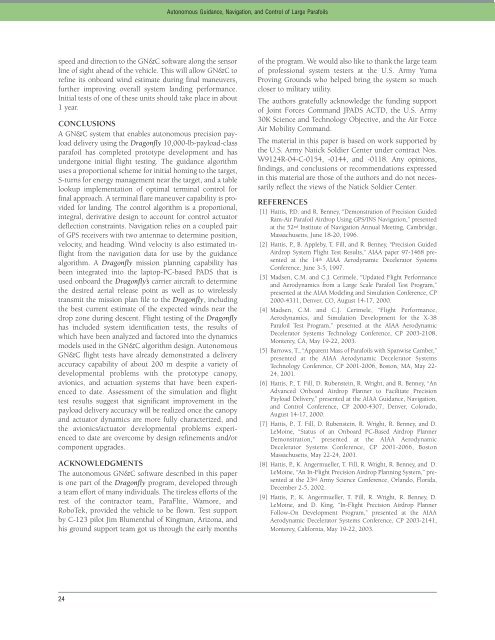TECHNOLOGY DIGEST - Draper Laboratory
TECHNOLOGY DIGEST - Draper Laboratory
TECHNOLOGY DIGEST - Draper Laboratory
Create successful ePaper yourself
Turn your PDF publications into a flip-book with our unique Google optimized e-Paper software.
speed and direction to the GN&C software along the sensor<br />
line of sight ahead of the vehicle. This will allow GN&C to<br />
refine its onboard wind estimate during final maneuvers,<br />
further improving overall system landing performance.<br />
Initial tests of one of these units should take place in about<br />
1 year.<br />
CONCLUSIONS<br />
A GN&C system that enables autonomous precision payload<br />
delivery using the Dragonfly 10,000-lb-payload-class<br />
parafoil has completed prototype development and has<br />
undergone initial flight testing. The guidance algorithm<br />
uses a proportional scheme for initial homing to the target,<br />
S-turns for energy management near the target, and a table<br />
lookup implementation of optimal terminal control for<br />
final approach. A terminal flare maneuver capability is provided<br />
for landing. The control algorithm is a proportional,<br />
integral, derivative design to account for control actuator<br />
deflection constraints. Navigation relies on a coupled pair<br />
of GPS receivers with two antennae to determine position,<br />
velocity, and heading. Wind velocity is also estimated inflight<br />
from the navigation data for use by the guidance<br />
algorithm. A Dragonfly mission planning capability has<br />
been integrated into the laptop-PC-based PADS that is<br />
used onboard the Dragonfly’s carrier aircraft to determine<br />
the desired aerial release point as well as to wirelessly<br />
transmit the mission plan file to the Dragonfly, including<br />
the best current estimate of the expected winds near the<br />
drop zone during descent. Flight testing of the Dragonfly<br />
has included system identification tests, the results of<br />
which have been analyzed and factored into the dynamics<br />
models used in the GN&C algorithm design. Autonomous<br />
GN&C flight tests have already demonstrated a delivery<br />
accuracy capability of about 200 m despite a variety of<br />
developmental problems with the prototype canopy,<br />
avionics, and actuation systems that have been experienced<br />
to date. Assessment of the simulation and flight<br />
test results suggest that significant improvement in the<br />
payload delivery accuracy will be realized once the canopy<br />
and actuator dynamics are more fully characterized, and<br />
the avionics/actuator developmental problems experienced<br />
to date are overcome by design refinements and/or<br />
component upgrades.<br />
ACKNOWLEDGMENTS<br />
The autonomous GN&C software described in this paper<br />
is one part of the Dragonfly program, developed through<br />
a team effort of many individuals. The tireless efforts of the<br />
rest of the contractor team, ParaFlite, Wamore, and<br />
RoboTek, provided the vehicle to be flown. Test support<br />
by C-123 pilot Jim Blumenthal of Kingman, Arizona, and<br />
his ground support team got us through the early months<br />
24<br />
Autonomous Guidance, Navigation, and Control of Large Parafoils<br />
of the program. We would also like to thank the large team<br />
of professional system testers at the U.S. Army Yuma<br />
Proving Grounds who helped bring the system so much<br />
closer to military utility.<br />
The authors gratefully acknowledge the funding support<br />
of Joint Forces Command JPADS ACTD, the U.S. Army<br />
30K Science and Technology Objective, and the Air Force<br />
Air Mobility Command.<br />
The material in this paper is based on work supported by<br />
the U.S. Army Natick Soldier Center under contract Nos.<br />
W9124R-04-C-0154, -0144, and -0118. Any opinions,<br />
findings, and conclusions or recommendations expressed<br />
in this material are those of the authors and do not necessarily<br />
reflect the views of the Natick Soldier Center.<br />
REFERENCES<br />
[1] Hattis, P.D. and R. Benney, “Demonstration of Precision Guided<br />
Ram-Air Parafoil Airdrop Using GPS/INS Navigation,” presented<br />
at the 52 nd Institute of Navigation Annual Meeting, Cambridge,<br />
Massachusetts, June 18-20, 1996.<br />
[2] Hattis, P., B. Appleby, T. Fill, and R. Benney, “Precision Guided<br />
Airdrop System Flight Test Results,” AIAA paper 97-1468 presented<br />
at the 14th AIAA Aerodynamic Decelerator Systems<br />
Conference, June 3-5, 1997.<br />
[3] Madsen, C.M. and C.J. Cerimele, “Updated Flight Performance<br />
and Aerodynamics from a Large Scale Parafoil Test Program,”<br />
presented at the AIAA Modeling and Simulation Conference, CP<br />
2000-4311, Denver, CO, August 14-17, 2000.<br />
[4] Madsen, C.M. and C.J. Cerimele, “Flight Performance,<br />
Aerodynamics, and Simulation Development for the X-38<br />
Parafoil Test Program,” presented at the AIAA Aerodynamic<br />
Decelerator Systems Technology Conference, CP 2003-2108,<br />
Monterey, CA, May 19-22, 2003.<br />
[5] Barrows, T., “Apparent Mass of Parafoils with Spanwise Camber,”<br />
presented at the AIAA Aerodynamic Decelerator Systems<br />
Technology Conference, CP 2001-2006, Boston, MA, May 22-<br />
24, 2001.<br />
[6] Hattis, P., T. Fill, D. Rubenstein, R. Wright, and R. Benney, “An<br />
Advanced Onboard Airdrop Planner to Facilitate Precision<br />
Payload Delivery,” presented at the AIAA Guidance, Navigation,<br />
and Control Conference, CP 2000-4307, Denver, Colorado,<br />
August 14-17, 2000.<br />
[7] Hattis, P., T. Fill, D. Rubenstein, R. Wright, R. Benney, and D.<br />
LeMoine, “Status of an Onboard PC-Based Airdrop Planner<br />
Demonstration,” presented at the AIAA Aerodynamic<br />
Decelerator Systems Conference, CP 2001-2066, Boston<br />
Massachusetts, May 22-24, 2001.<br />
[8] Hattis, P., K. Angermueller, T. Fill, R. Wright, R. Benney, and D.<br />
LeMoine, “An In-Flight Precision Airdrop Planning System,” presented<br />
at the 23nd Army Science Conference, Orlando, Florida,<br />
December 2-5, 2002.<br />
[9] Hattis, P., K. Angermueller, T. Fill, R. Wright, R. Benney, D.<br />
LeMoine, and D. King, “In-Flight Precision Airdrop Planner<br />
Follow-On Development Program,” presented at the AIAA<br />
Aerodynamic Decelerator Systems Conference, CP 2003-2141,<br />
Monterey, California, May 19-22, 2003.

















